Drift Potential Characteristics of a Flat Fan Nozzle: A Numerical and Experimental Study
Abstract
:1. Introduction
2. Model Construction and Numerical Simulation
2.1. Geometric Model Establishment and Mesh Generation
2.2. Numerical Calculation Model
2.2.1. Continuous Phase-Model Selection
2.2.2. Discrete-Phase Model Selection
2.2.3. Test Parameter Setting
- (1)
- Discrete-phase-injection source parameters: The discrete-phase material was water, and the discrete-phase-release position coordinates were (x, y, z) = (0, 0.6, 0). The axial vector component of the nozzle was (x, y, z) = (0, −1, 0). The droplet mass flow rate was 0.02 kg/s, the half angle of spraying was 60°, and the spray diffusion angle was 6°. Unsteady particle tracking was enabled, the discrete random walk model was adopted, and the particle release time scale constant was 0.01 s.
- (2)
- Boundary conditions: For the fluid boundary condition, x = −2.5, the plane of the box body area was the velocity inlet boundary, the velocities were 0 m/s, 1 m/s, 2 m/s, 3 m/s, 4 m/s, 5 m/s, and 6 m/s, respectively. The free outflow boundary plane corresponded to x = 17.5, and the other surfaces were the wall boundaries. For the DPM boundary condition type of discrete-phase, the fluid entered from the inlet and escaped from the outlet, the wall film was formed on the ground, and the rest of the boundary fluid mass was rebound. The material in the computational domain was set to ideal air.
- (3)
- Solution method and simulation parameters: The pressure velocity coupling mode was simple, the transient formula was second-order implicit, and the iterative time step was 0.01 s. When studying the influence of wind speed on droplet size, the simulated spraying time was 0.005 s. After spraying, the total particle-size distribution in the statistical flow field was delayed by 0.01 s, allowing for the full collision or polymerization of discrete particles in the air to occur. Simultaneously, the average flight length of discrete particles from the nozzle to the conventional droplet statistical position was 0.35 m. When studying the drift characteristics of droplet deposition, the simulated spray duration was 5 s.
2.3. Numerical Results
2.3.1. Computational Method
2.3.2. Simulated Droplet Parameters
3. Wind Tunnel Test
3.1. Test Materials and Equipment
3.2. Wind Tunnel Test Design
4. Results and Discussion
4.1. Droplet Parameters of Wind Tunnel Test
4.2. Comparison and Analysis of Data and Results
5. Conclusions
- (1)
- The droplet spectrum parameters and droplet drift results correlated with the test and can be obtained through measurement and analysis of the actual spraying process and the establishment of an appropriate spraying model. The statistical results of the data from the simulation of all droplet particle sizes for a short duration compared to the droplet particle sizes on a line tested by a particle-sizer laser beam were poor. However, the numerical simulation accurately predicted droplet drift.
- (2)
- Under different spray conditions, the characteristic height of the droplet drift h, the drift distance, the accurate deposition rate Ra, and the horizontal drift rate Rh were directly affected by the lateral wind speed. For the simulation results, the accurate deposition rate of Ra at wind speeds of 1 m/s and 6 m/s were 10.04% and 0.66%, respectively. The horizontal drift rate Rh at wind speeds of 1 m/s and 6 m/s were 21.28% and 60.58%, respectively. According to the test results, the characteristic height h at wind speeds of 1 m/s and 6 m/s were 0.175 m and 0.245 m, respectively. The horizontal drift rate at wind speeds of 1 and 6 m/s was 0.4% and 75.1%, respectively. For different wind speeds, the correlation between the results of the numerical simulation and wind tunnel test for drift and drift data was more than 0.9.
- (3)
- Compared with wind tunnel tests, hydrodynamic modeling and analysis can greatly save computation and experimentation resources by ensuring the correlation of results. Meanwhile, its results can be accurately visualized, and the test result data can be easily analyzed through statistics, reducing post-processing time.
Author Contributions
Funding
Institutional Review Board Statement
Informed Consent Statement
Data Availability Statement
Acknowledgments
Conflicts of Interest
References
- Liu, X.; Liu, X.; Cui, H.; Yuan, J. Research progress and prospect of crop canopy droplet deposition. J. Agric. Mach. 2021, 1–20. Available online: http://kns.cnki.net/kcms/detail/11.1964.S.20210917.1110.006.html (accessed on 2 March 2022).
- Dekeyser, D.; Duga, A.T.; Verboven, P.; Endalew, A.M.; Hendrickx, N.; Nuyttens, D. Assessment of orchard sprayers using laboratory experiments and computational fluid dynamics modelling. Biosyst. Eng. 2013, 114, 157–169. [Google Scholar] [CrossRef]
- Liu, X.; Yuan, L.; Shi, X.; Du, Y.; Yang, F.; Yuan, H.; Min, X. Research progress of droplet drift in spray for plant protection spraying. J. Pes. Sci. 2021, 1–21. [Google Scholar] [CrossRef]
- Zhou, Z.; Ming, R.; Zang, Y.; He, X.; Luo, X.; Lan, Y. Development status and countermeasures of agricultural aviation in China. Trans. Chin. Soc. Agric. Mach. 2017, 33, 1–13, (In Chinese, with Abstract in English). [Google Scholar]
- Zhang, J.; He, X.; Song, J.; Zeng, A.; Liu, Y.; Li, X. Influence of spraying parameters of unmanned aircraft on droplets deposition. Trans. Chin. Soc. Agric. Mach. 2012, 43, 94–96, (In Chinese, with Abstract in English). [Google Scholar]
- Chen, S.; Lan, Y.; Li, J.; Zhou, Z.; Liu, A.; Xu, X. Comparison of the pesticide effects of aerial and artificial spray applications for rice. J. South China Agric. Univ. 2017, 38, 103–109, (In Chinese, with Abstract in English). [Google Scholar]
- Wang, C.; Song, J.; He, X.; Wang, Z.; Wang, S.; Meng, Y. Effect of flight parameters on distribution characteristics of pesticide spraying droplets deposition of plant-protection unmanned aerial vehicle. Trans. Chin. Soc. Agric. Eng. 2017, 33, 109–116, (In Chinese, with Abstract in English). [Google Scholar]
- van de Zande, J.C.; Huijsmans, J.F.; Porskamp, H.A.; Michielsen, J.M.; Stallinga, H.; Holterman, H.J.; de Jong, A.J. Spray techniques: How to optimise spray deposition and minimise spray drift. Environmentalist 2008, 28, 9–17. [Google Scholar] [CrossRef] [Green Version]
- Van de Zande, J.C.; Stallinga, H.; Michielsen, J.M.; Van Velde, P. Effect of sprayer speed on spray drift. Annu. Rev. Agric. Eng. 2005, 4, 129–142. [Google Scholar]
- Derksen, R.C.; Zhu, H.; Ozkan, H.E.; Hammond, R.B.; Dorrance, A.E.; Spongberg, A.L. Determining the influence of spray quality, nozzle type, spray volume, and air-assisted application strategies on deposition of pesticides in soybean canopy. Trans. ASABE 2008, 51, 1529–1537. [Google Scholar] [CrossRef] [Green Version]
- Salcedo, R.; Zhu, H.; Zhang, Z.; Wei, Z.; Chen, L.; Ozkan, E.; Falchieri, D. Foliar deposition and coverage on young apple trees with PWM-controlled spray systems. Comput. Electron. Agric. 2020, 178, 105794. [Google Scholar] [CrossRef]
- Salcedo, R.; Zhu, H.; Ozkan, E.; Falchieri, D.; Zhang, Z.; Wei, Z. Reducing ground and airborne drift losses in young apple orchards with PWM-controlled spray systems. Comput. Electron. Agric. 2021, 189, 106389. [Google Scholar] [CrossRef]
- Salyani, M.; Farooq, M.; Sweeb, R.D. Spray deposition and mass balance in citrus orchard applications. Trans. ASABE 2007, 50, 1963–1969. [Google Scholar] [CrossRef]
- Nuyttens, D.; De Schampheleire, M.; Baetens, K.; Sonck, B. The influence of operator-controlled variables on spray drift from field crop sprayers. Trans. ASABE 2007, 50, 1129–1140. [Google Scholar] [CrossRef]
- Nuyttens, D.; Zwertvaegher, I.K.; Dekeyser, D. Spray drift assessment of different application techniques using a drift test bench and comparison with other assessment methods. Biosyst. Eng. 2017, 154, 14–24. [Google Scholar] [CrossRef]
- Balsari, P.; Gil, E.; Marucco, P.; Van De Zande, J.C.; Nuyttens, D.; Herbst, A.; Gallart, M. Field-crop-sprayer potential drift measured using test bench: Effects of boom height and nozzle type. Biosyst. Eng. 2017, 154, 3–13. [Google Scholar] [CrossRef] [Green Version]
- Balsari, P.; Grella, M.; Marucco, P.; Matta, F.; Miranda-Fuentes, A. Assessing the influence of air speed and liquid flow rate on the droplet size and homogeneity in pneumatic spraying. Pest Manag. Sci. 2019, 75, 366–379. [Google Scholar] [CrossRef]
- Miranda-Fuentes, A.; Marucco, P.; Sánchez, E.J.G.; Gil, E.; Grella, M.; Balsari, P. Developing strategies to reduce spray drift in pneumatic spraying in vineyards: Assessment of the parameters affecting droplet size in pneumatic spraying. Sci. Total Environ. 2018, 616, 805–815. [Google Scholar] [CrossRef] [Green Version]
- Butts, T.R.; Luck, J.D.; Fritz, B.K.; Hoffmann, W.C.; Kruger, G.R. Evaluation of spray pattern uniformity using three unique analyses as impacted by nozzle, pressure, and pulse-width modulation duty cycle. Pest Manag. Sci. 2019, 75, 1875–1886. [Google Scholar] [CrossRef] [Green Version]
- Guler, H.; Zhu, H.; Ozkan, H.E.; Derksen, R.C.; Yu, Y.; Krause, C.R. Spray characteristics and drift reduction potential with air induction and conventional flat-fan nozzles. Trans. ASABE 2007, 50, 745–754. [Google Scholar] [CrossRef]
- Guler, H.; Zhu, H.; Ozkan, E.; Derksen, R.; Krause, C. Wind tunnel evaluation of drift reduction potential and spray characteristics with drift retardants at high operating pressure. J. ASTM Int. 2006, 3, 1–9. [Google Scholar] [CrossRef] [Green Version]
- Guler, H.; Zhu, H.; Ozkan, H.E.; Derksen, R.C.; Yu, Y.; Krause, C.R. Spray characteristics and wind tunnel evaluation of drift reduction potential with air induction and conventional flat fan nozzle. In Proceedings of the 2006 ASAE Annual Meeting. American Society of Agricultural and Biological Engineers, Boston, MA, USA, 19–22 August 2006; p. 1. [Google Scholar]
- Zhang, J.; Song, J.; He, X.; Zeng, A.; Liu, Y. Droplets movement characteristics in atomization process of flat nozzle. Trans. Chin. Soc. Agric. Mach. 2011, 42, 66–69+75. (In Chinese) [Google Scholar]
- Zhang, S.; Xue, X.; Qin, W.; Sun, Z.; Ding, S.; Zhou, L. Simulation and experimental verification of aerial spraying drift on N-3 unmanned spraying helicopter. Trans. Chin. Soc. Agric. Mach. 2015, 31, 87–93, (In Chinese, with Abstract in English). [Google Scholar]
- Teske, M.E.; Thistle, H.W.; Hewitt, A.J.; Kirk, I.W.; Dexter, R.W.; Ghent, J.H. Rotary atomizer drop size distribution database. Trans. ASABE 2005, 48, 917–921. [Google Scholar] [CrossRef] [Green Version]
- Kirk, I.W. Measurement and prediction of atomization parameters from fixed-wing aircraft spray nozzles. Trans. ASABE 2007, 50, 693–703. [Google Scholar] [CrossRef]
- Fritz, B.K.; Hoffmann, W.C.; Lan, Y. Evaluation of the EPA drift reduction technology (DRT) low-speed wind tunnel protocol. J. ASTM Int. 2009, 6, 183–191. [Google Scholar] [CrossRef] [Green Version]
- Hoffmann, W.C.; Fritz, B.K.; Lan, Y. Evaluation of a proposed drift reduction technology high-speed wind tunnel testing protocol. J. ASTM Int. 2009, 6, 212–223. [Google Scholar] [CrossRef]
- Martin, D.E.; Carlton, J.B. Airspeed and orifice size affect spray droplet spectrum from an aerial electrostatic nozzle for fixed-wing applications. Appl. Eng. Agric. 2013, 29, 5–10. [Google Scholar] [CrossRef]
- Zhang, F.; Feng, S.; Chen, L.; Zhang, R.; Li, L. Wind tunnel experimental study on drift potential characteristics of special-shaped nozzles with the same size. Res. Agric. Mech. 2021, 43, 157–164. [Google Scholar] [CrossRef]
- Zhang, H.; Gary, D.; Zheng, J.; Zhou, H. Wind tunnel experiment of influence on droplet size distribution of flat fan nozzles. Trans. Chin. Soc. Agric. Mach. 2012, 43, 53–57+52. [Google Scholar]
- Tang, Q.; Chen, L.; Zhang, R.; Zhang, B.; Yi, T.; Xu, M.; Xu, G. Atomization characteristics of normal flat fan nozzle and air induction nozzle under high-speed airflow conditions. Trans. Chin. Soc. Agric. Eng. 2016, 32, 121–128, (In Chinese, with Abstract in English). [Google Scholar]
- Duga, A.T.; Delele, M.A.; Ruysen, K.; Dekeyser, D.; Nuyttens, D.; Bylemans, D.; Nicolai, B.M.; Verboven, P. Development and validation of a 3D CFD model of drift and its application to air-assisted orchard sprayers. Biosyst. Eng. 2016, 154, 62–75. [Google Scholar] [CrossRef]
- Hong, S.W.; Zhao, L.; Zhu, H. CFD simulation of airflow inside tree canopies discharged from air-assisted sprayers. Comput. Electron. Agric. 2018, 149, 121–132. [Google Scholar] [CrossRef]
- Li, J.; Zhao, C.; Li, S.; Chen, H.; Ding, S. Research on droplet deposition characteristics of CFD wind driven sprayer based on CFD. J. Huazhong Agric. Univ. 2019, 38, 171–177. [Google Scholar] [CrossRef]
- Liu, X.; Yuan, J.; Zhang, X.; Zuo, W. Effect of air-assisted spraying condition parameters on boom spray drift characteristics. Trans. Chin. Soc. Agric. Mach. 2012, 43 (Suppl. S1), 67–72, (In Chinese, with Abstract in English). [Google Scholar]
- Zheng, L. ANSYS Fluent 15.0. Fluid Computing from Introduction to Mastery (m); Electronic Industry Press: Beijing, China, 2015; p. 115. [Google Scholar]
- ANSYS18.1—ANSYS Fluent Theory Guide Chapter 4: Turbulence p47 (Z); ANSYS, Inc.: Canonsburg, PA, USA, 2017.
- Wang, J.; Liu, C.; Wu, Y. Numerical simulation of spray atomization in supersonic flows. Mod. Phys. Lett. B 2010, 24, 1299–1302. [Google Scholar] [CrossRef]
- Zhang, H.; Gary, D.; Zheng, J.; Zhou, H.; Yu, J. Wind tunnel experiment and regression model for spray drift. Trans. Chin. Soc. Agric. Eng. 2015, 31, 94–100, (In Chinese, with Abstract in English). [Google Scholar]
- Fu, X.; Wu, P.; Ding, S.; Zhou, L.; Yan, H. Influence of spray operating parameters on droplet deposition. Trans. Chin. Soc. Agric. Mach. 2011, 42, 70–75, (In Chinese, with Abstract in English). [Google Scholar]
- Fritz, B.K.; Hoffmann, W.C.; Bagley, W.E.; Kruger, G.R.; Czaczyk, Z.; Henry, R.S. Measuring droplet size of agricultural spray nozzles-measurement distance and air speed effects. At. Sprays 2014, 24, 747–760. [Google Scholar] [CrossRef] [Green Version]
- Hoffmann, W.C.; Fritz, B.K.; Bagley, W.E.; Lan, Y. Effects of air speed and liquid temperature on droplet size. J. ASTM Int. 2011, 8, 1–9. [Google Scholar] [CrossRef]
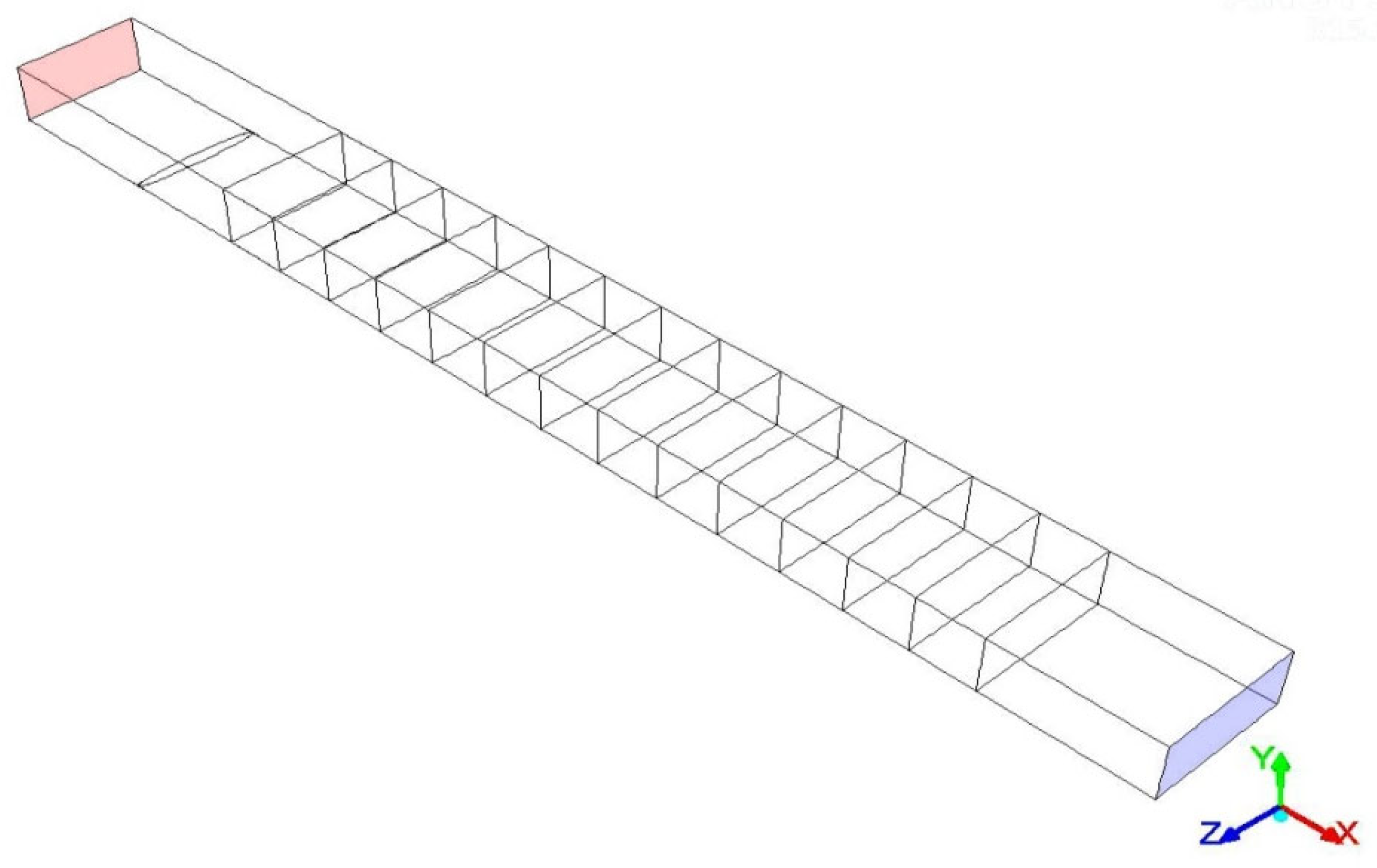
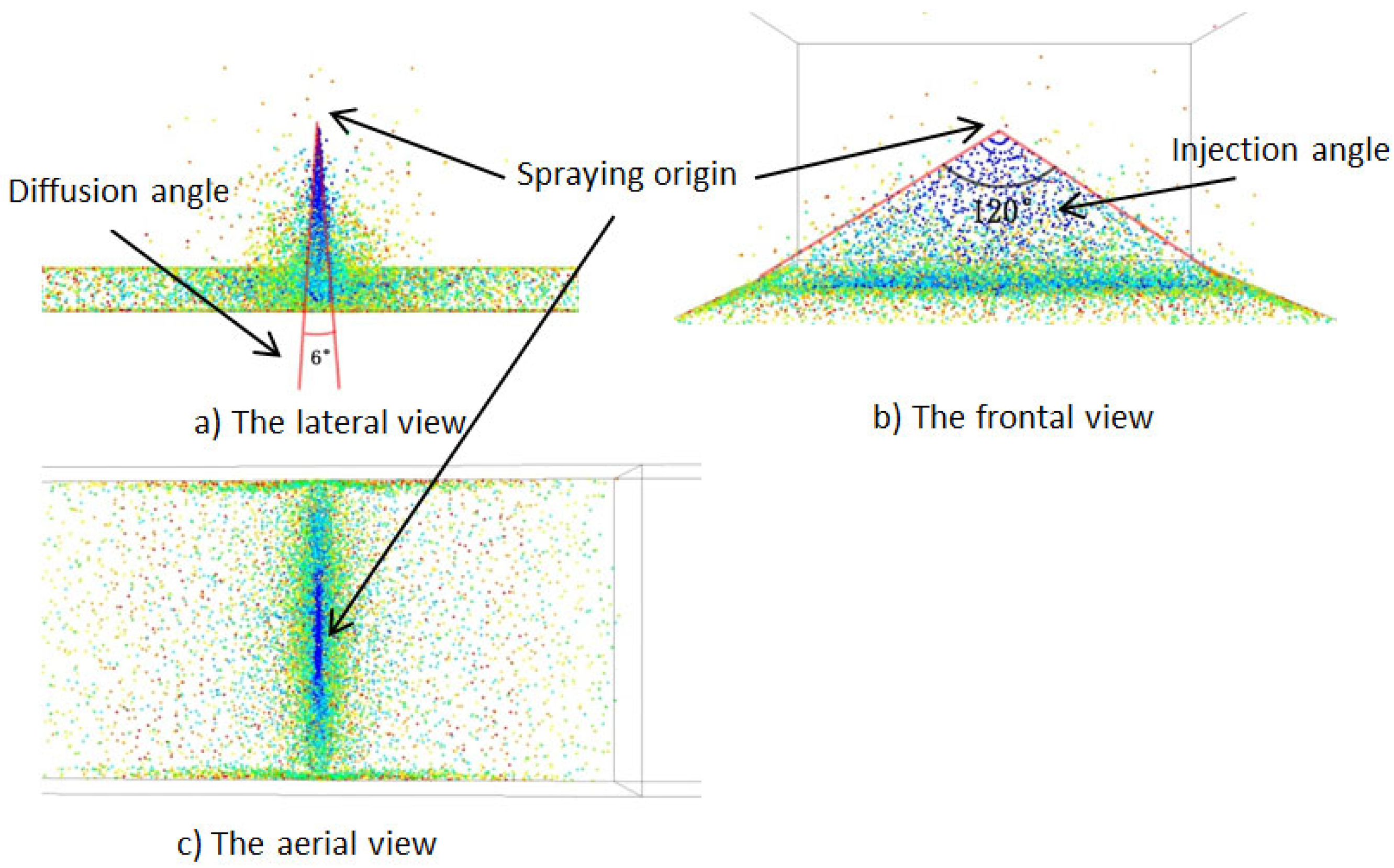

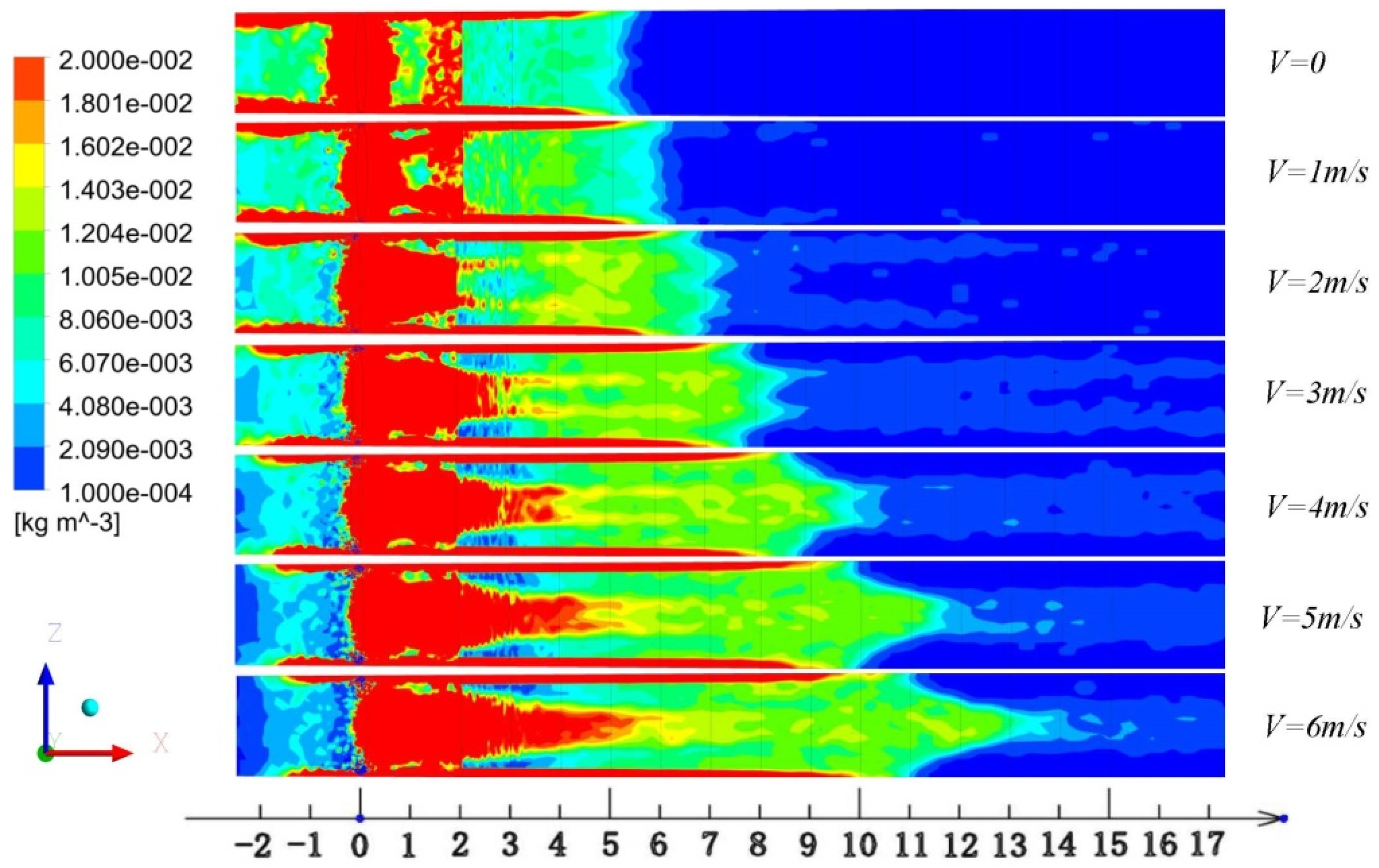
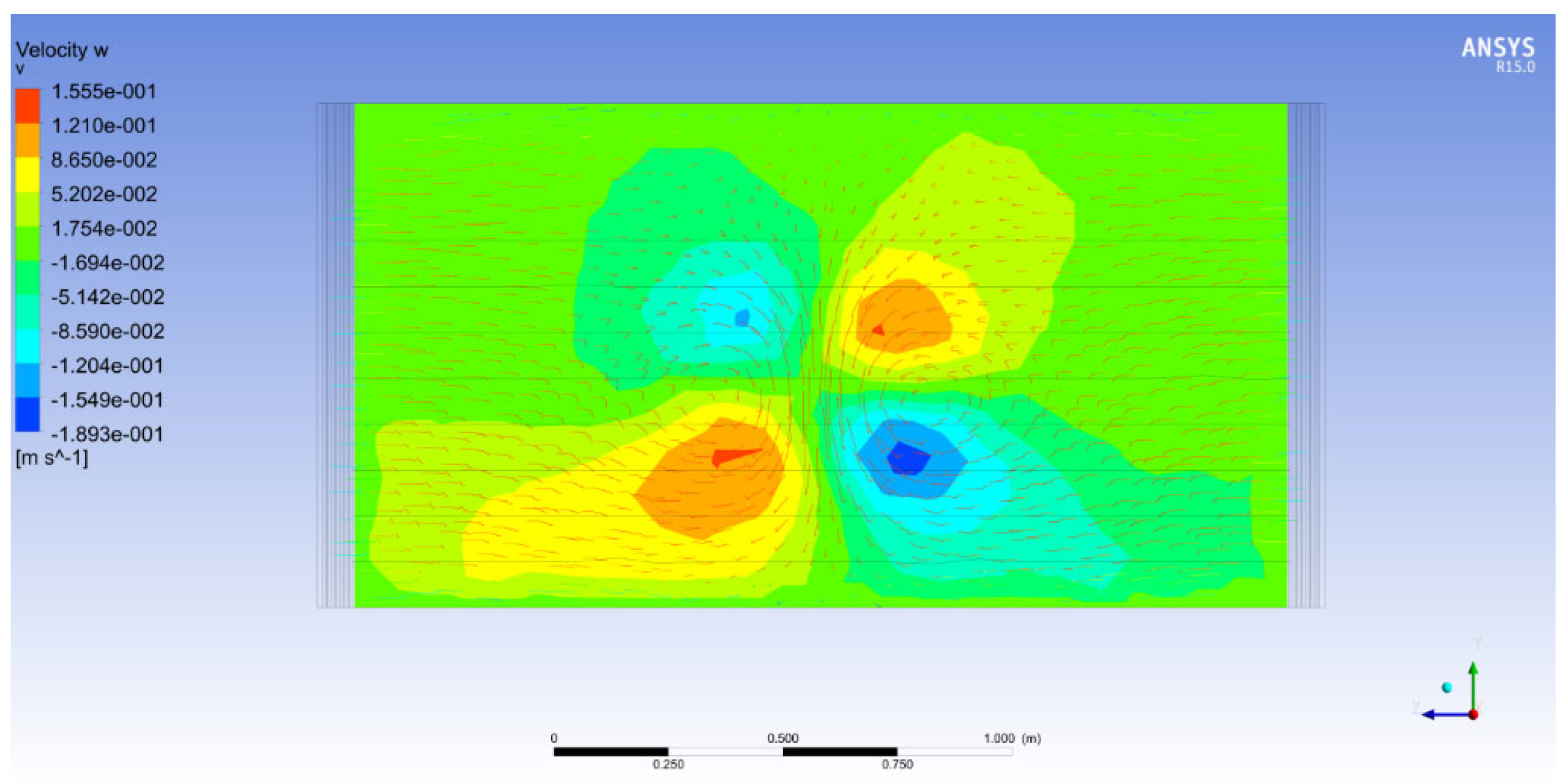
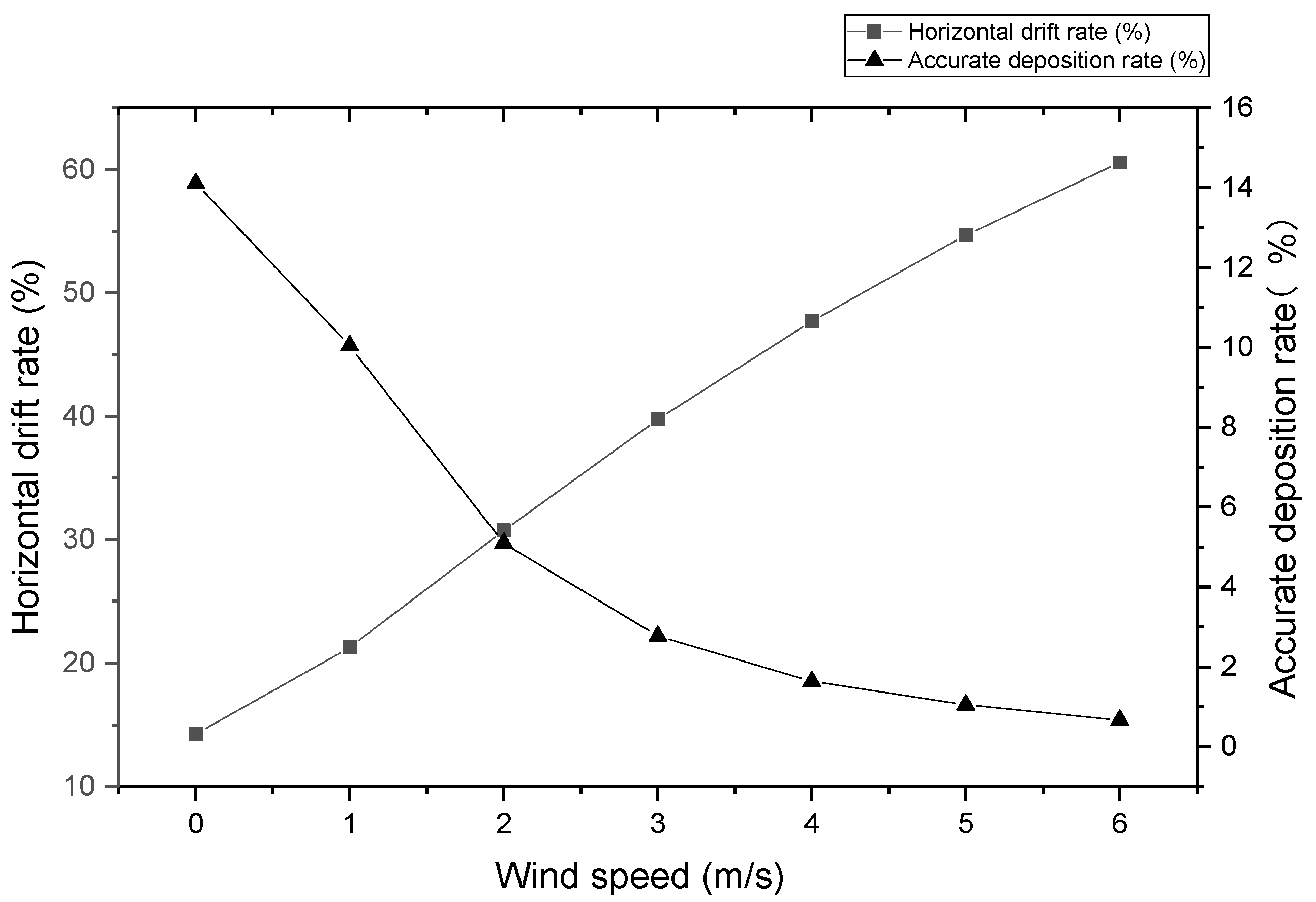
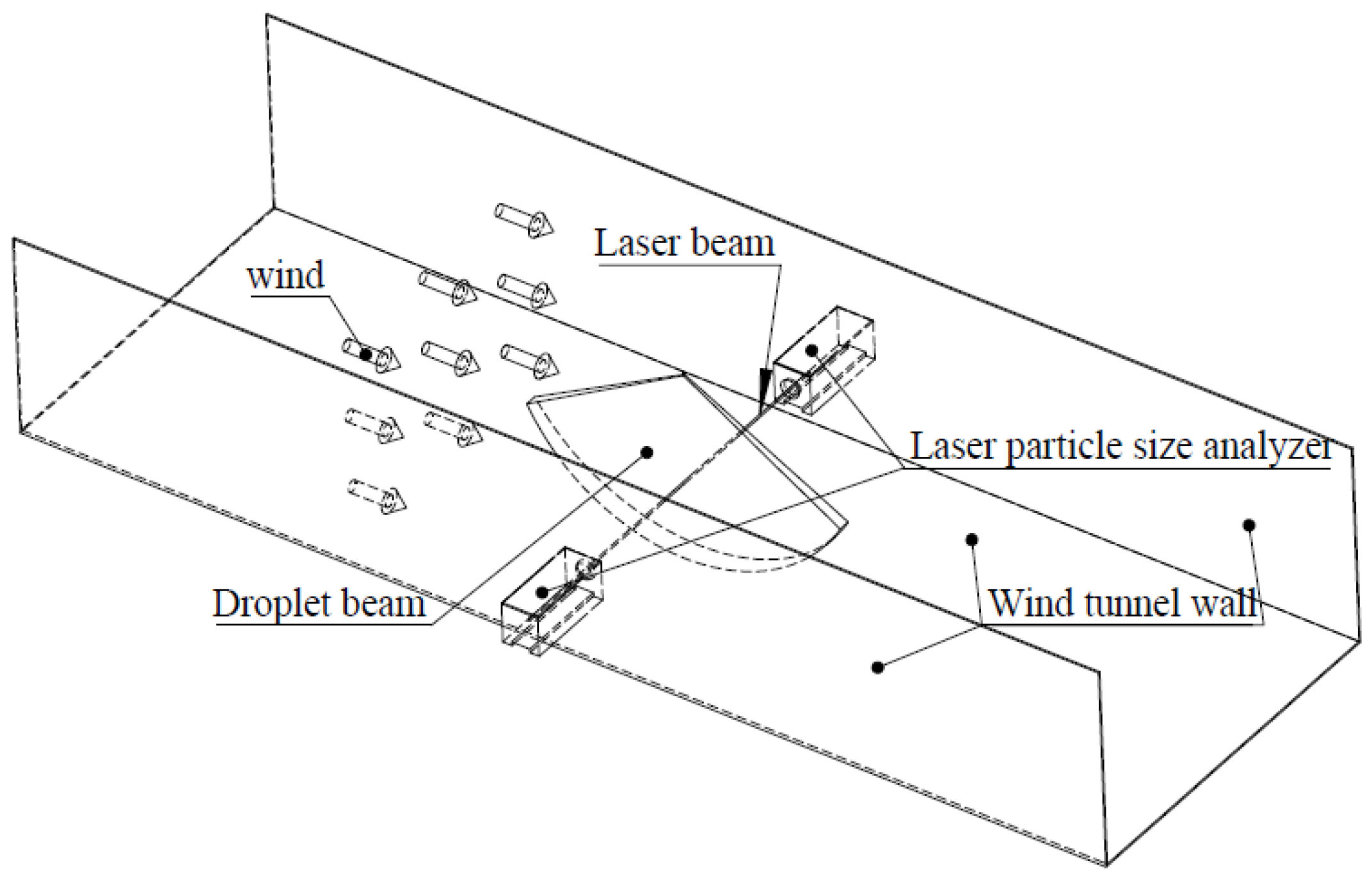
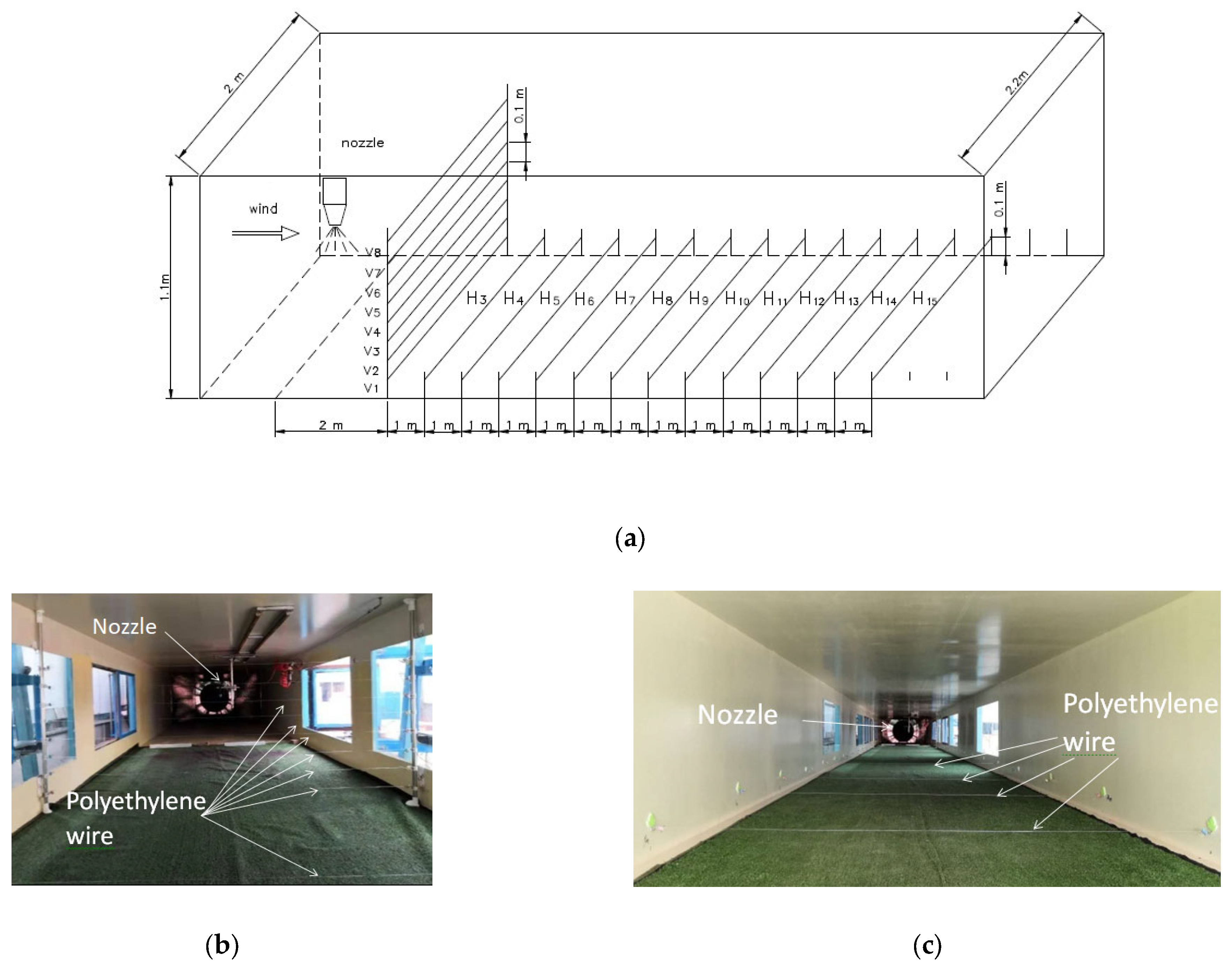
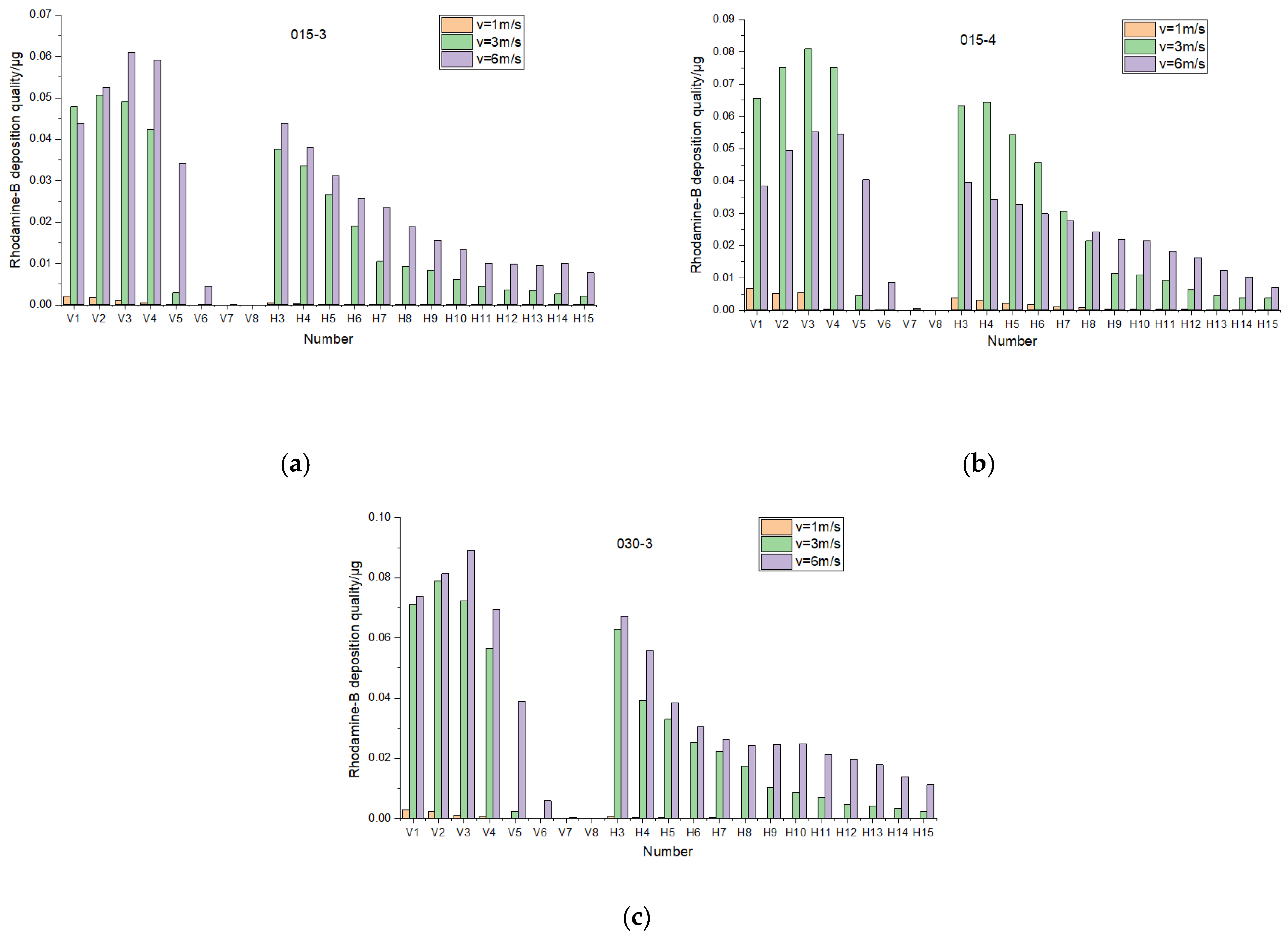
| Horizontal Wind Speed/m/s | 0 | 1 | 2 | 3 | 4 | 5 | 6 |
|---|---|---|---|---|---|---|---|
| Dv0.1/μm | 100.00 | 105.78 | 126.11 | 125.97 | 121.46 | 127.34 | 119.01 |
| Dv0.5/μm | 218.49 | 229.05 | 225.51 | 227.10 | 235.25 | 238.84 | 241.78 |
| Dv0.9/μm | 351.38 | 339.51 | 349.15 | 333.13 | 358.99 | 347.56 | 346.98 |
| V100/% | 10.21% | 5.70% | 3.96% | 4.04% | 4.30% | 4.68% | 5.36% |
| Droplet Spectrum Width | 1.15 | 1.02 | 0.92 | 0.91 | 1.01 | 0.92 | 1.01 |
| Nozzle Type/Spray Pressure/(No. MPa) | Wind Speed (m/s) | |||||||
|---|---|---|---|---|---|---|---|---|
| 0 | 1 | 2 | 3 | 4 | 5 | 6 | ||
| Lu120-015, 0.3 | Dv0.1/μm | 84.24 | 82.47 | 79.35 | 72.77 | 72.71 | 71.69 | 69.26 |
| Dv0.5/μm | 174.74 | 176.68 | 177.67 | 179.31 | 187.53 | 191.22 | 195.32 | |
| Dv0.9/μm | 264.55 | 276.32 | 281.54 | 289.48 | 298.35 | 309.74 | 318.81 | |
| V100/% | 11.84 | 12.17 | 13.76 | 14.73 | 14.63 | 14.27 | 14.01 | |
| Droplet spectrum width | 1.03 | 1.10 | 1.14 | 1.21 | 1.20 | 1.24 | 1.28 | |
| Lu120-015, 0.4 | Dv0.1/μm | 81.98 | 76.80 | 73.49 | 71.97 | 70.25 | 69.34 | 66.60 |
| Dv0.5/μm | 171.02 | 172.14 | 175.64 | 178.86 | 182.71 | 186.34 | 190.52 | |
| Dv0.9/μm | 261.29 | 269.51 | 276.36 | 279.76 | 287.91 | 295.78 | 304.32 | |
| V100/% | 13.86 | 14.82 | 15.64 | 15.98 | 17.32 | 18.19 | 18.32 | |
| Droplet spectrum width | 1.05 | 1.12 | 1.16 | 1.16 | 1.19 | 1.22 | 1.25 | |
| Lu120-03, 0.3 | Dv0.1/μm | 96.62 | 91.75 | 89.37 | 87.91 | 85.46 | 83.17 | 82.78 |
| Dv0.5/μm | 216.58 | 217.82 | 221.95 | 225.24 | 230.16 | 234.31 | 237.34 | |
| Dv0.9/μm | 340.53 | 371.55 | 386.36 | 404.53 | 418.26 | 431.53 | 440.86 | |
| V100/% | 11.84 | 12.17 | 13.76 | 14.73 | 15.63 | 16.27 | 16.01 | |
| Droplet spectrum width | 1.13 | 1.28 | 1.34 | 1.41 | 1.45 | 1.49 | 1.51 | |
| Wind Speed/m/s | Nozzle Model/Spray Pressure/(No./MPa) | ||
|---|---|---|---|
| Lu 120-015, 0.3 | Lu 120-015, 0.4 | Lu 120-120, 0.3 | |
| 1 | 3.12 | 11 | 3.88 |
| 3 | 15.74 | 16.45 | 16.24 |
| 6 | 18.63 | 17.87 | 20 |
| Wind Speed/m/s | 1 | 3 | 6 | |||
|---|---|---|---|---|---|---|
| Distance/m | Numerical Simulation | Test Value | Numerical Simulation | Test Value | Numerical Simulation | Test Value |
| 3 | 0.006403 | 0.00064 | 0.009923 | 0.062848 | 0.013863 | 0.0672 |
| 4 | 0.004032 | 0.000293 | 0.006228 | 0.039051 | 0.008777 | 0.055733 |
| 5 | 0.002681 | 0.000213 | 0.004843 | 0.032853 | 0.006894 | 0.038293 |
| 6 | 0.001431 | 0.00016 | 0.003942 | 0.02528 | 0.005624 | 0.03032 |
| 7 | 0.000147 | 0.000267 | 0.003108 | 0.02224 | 0.004611 | 0.026267 |
| 8 | 1.79 × 105 | 0.000107 | 0.001981 | 0.01744 | 0.003935 | 0.02424 |
| 9 | 1.76 × 105 | 0.00008 | 0.000511 | 0.010347 | 0.003367 | 0.024613 |
| 10 | 3.01 × 106 | 2.67 × 105 | 0.000149 | 0.008811 | 0.00282 | 0.0248 |
| 11 | 1.6 × 108 | 0.000107 | 0.000124 | 0.007061 | 0.00233 | 0.021333 |
| 12 | 1.78 × 106 | 5.33 × 105 | 9.97 × 105 | 0.004597 | 0.001436 | 0.019733 |
| 13 | 2.54 × 106 | 2.67 × 105 | 6.32 × 105 | 0.004155 | 0.000798 | 0.017867 |
| 14 | 3.74 × 108 | 2.67 × 105 | 6.34 × 105 | 0.003291 | 0.000309 | 0.013867 |
| 15 | 1.03 × 106 | 0 | 4.3 × 105 | 0.002347 | 0.000161 | 0.0112 |
Publisher’s Note: MDPI stays neutral with regard to jurisdictional claims in published maps and institutional affiliations. |
© 2022 by the authors. Licensee MDPI, Basel, Switzerland. This article is an open access article distributed under the terms and conditions of the Creative Commons Attribution (CC BY) license (https://creativecommons.org/licenses/by/4.0/).
Share and Cite
Wang, J.; Liang, Q.; Zeng, T.; Zhang, X.; Fu, W.; Lan, Y. Drift Potential Characteristics of a Flat Fan Nozzle: A Numerical and Experimental Study. Appl. Sci. 2022, 12, 6092. https://doi.org/10.3390/app12126092
Wang J, Liang Q, Zeng T, Zhang X, Fu W, Lan Y. Drift Potential Characteristics of a Flat Fan Nozzle: A Numerical and Experimental Study. Applied Sciences. 2022; 12(12):6092. https://doi.org/10.3390/app12126092
Chicago/Turabian StyleWang, Juan, Qifu Liang, Tiwei Zeng, Xirui Zhang, Wei Fu, and Yubin Lan. 2022. "Drift Potential Characteristics of a Flat Fan Nozzle: A Numerical and Experimental Study" Applied Sciences 12, no. 12: 6092. https://doi.org/10.3390/app12126092
APA StyleWang, J., Liang, Q., Zeng, T., Zhang, X., Fu, W., & Lan, Y. (2022). Drift Potential Characteristics of a Flat Fan Nozzle: A Numerical and Experimental Study. Applied Sciences, 12(12), 6092. https://doi.org/10.3390/app12126092






